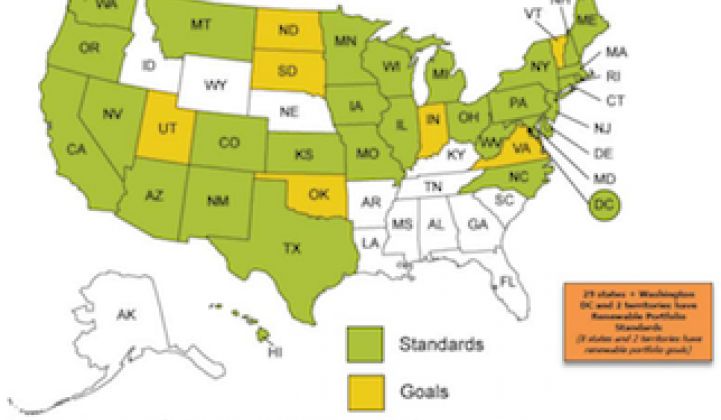As many who work in cleantech or environmental circles probably noticed, a warm, fuzzy feeling was palpable on Tuesday as Obama wiped the sweat from his brow repeatedly and delivered a long-awaited address about how his administration plans to tackle climate change.
The sentiment was no different at the 10th annual Renewable Energy Finance Forum-Wall Street in New York City. Clapping broke out a few times as the speech was streamed live. Twitter feeds were abuzz. None of the attendees seemed to be checking email on their smartphones.
Despite the enthusiasm for changes that Obama called for, including limiting carbon emissions from existing power plants and a doubling of U.S. renewable energy production, panelists at the conference kept returning to the efforts at the state level. If we are serious about transforming utilities, which are responsible for about 40 percent of U.S. greenhouse gas emissions, much of the hard work will have to come from states, despite the president’s resolve.
In a study released just hours before President Obama’s speech, the American Council on Renewable Energy (ACORE), CalCEF and the Climate Policy Initiative highlighted the interplay between state and federal policy, but also showcased how moves by states -- including aggressive renewable portfolio standards (RPS) and green banks -- are pushing renewable investment forward.
The paper didn’t downplay the importance of federal incentives, but rather showed how federal policies have helped states meet their renewable portfolio standards. The study called for “extending the successful PTC and ITC policies; enabling renewable energy access to the highest-value new private finance techniques, and MLP and REIT investment,” but then turned to states. The subject of new utility models, where utilities can be energy service providers, was repeated.
“You’re trying to introduce a new technology into a heavily regulated sector,” said Uday Varadarajan, a senior policy analyst at Climate Policy Initiative and an author of the report.
“State markets are working,” said Dan Adler, managing director at CalCEF and report author. “If we’re going to scale, federal tax credits are not the financial mechanism that will take us there.” He added that what is needed is a combination of finance options and grid improvements.
Grid improvement, however, is largely a state issue. Some states, like California, have required their utilities to develop roadmaps for grid modernization to support the RPS. Even the implementation of any future EPA rules that regulate greenhouse gas emissions will still be a state-by-state endeavor. By regulating carbon emissions from existing coal plants, Obama is essentially forcing utilities to take the cost of pollution into consideration for generation fleets. But many states and regional transmission organizations and grid operators are already planning for a future with less coal, and are turning to increased transmission for wind and gas-fired power plants to demand response to meet future demand. Other organizations, such as the National Rural Electric Cooperative Association, have already come out against Obama's proposals.
How Will States Move Forward?
At the state level, it is the public utility commissions that largely dictate how investor-owned utilities operate. “You can’t think about utilities without thinking about the regulatory structure,” said Varadarajan. While limiting carbon emissions will shut down the dirtiest of power plants, it won’t necessarily encourage smart grid investment, which will be necessary for high levels of distributed generation. “A shift to cleaner energy and investors will come in at the end of the day if they’re driven by consumers,” Varadarajan said of changes to the utility model, such as what’s happening in California with the popularity of solar leases. “We need green power programs on steroids.”
Some high-level state administrators are already talking along those lines. “As cost of distributed solutions go down, the individual is becoming cheaper than the collective,” said Richard Kauffman, New York’s chairman of energy policy and finance. “The collective was the whole reason for the utility in the first place.” Kauffman did not speak in specifics about changes that are being considered in New York, but he raised the question of how utilities can be incentivized differently to invest in efficiency and offer more options to customers.
Another driver that could open up markets for energy efficiency and renewable investment is state-run green banks like the one New York is building. But green banks won’t incentivize utilities to fundamentally change the way they do business.
One option is to allow utilities to look more like cable providers, according to Vice Admiral Dennis V. McGinn, president of ACORE. He said people could pay for a minimum service, like basic cable, that would support the grid. Then utilities can offer additional services, whether it’s tiered reliability for large commercial and industrial customers or rooftop solar leases for homeowners. California is already considering changes to rate design as more people move to residential solar. However, if distributed renewables and microgrids become the Hulu and Netflix of power generation, utilities and commissioners will have to be more creative than offering a few rate tweaks to support the larger power grid.
During a panel about microgrids at REFF, David Cohen, managing partner of E7 Ventures, a developer of hybrid renewable systems, noted the movement afoot in his home of Boulder, CO to build a municipal utility to displace Xcel Energy because residents want more renewable energy faster than the large utility can deliver it. “Sometimes the IOU and regulatory process gets in the way,” Cohen said of investing in renewables and building the utility of the future. “But once people succeed at developing their own methods to do this, the very smart utilities will quickly adapt.”
In the coming days and weeks, we’ll see which utilities and states are poised to embrace Obama’s climate plan -- and which ones are ready for a fight.



